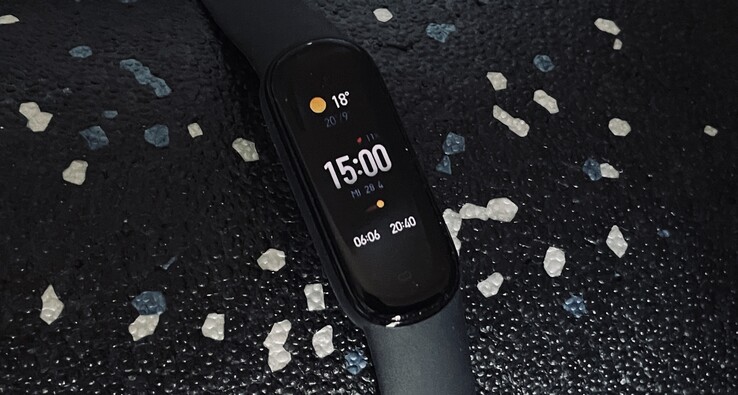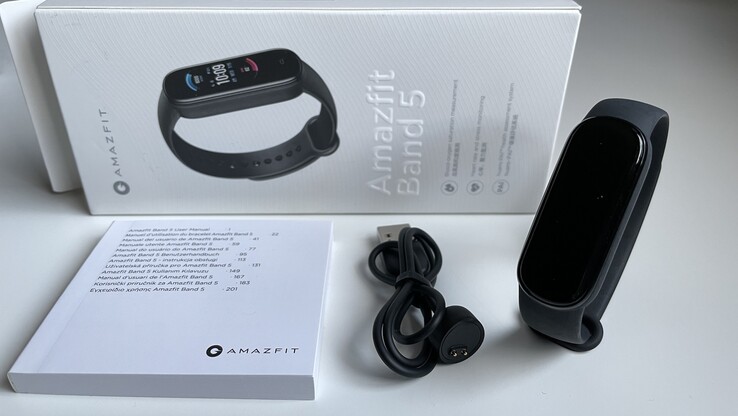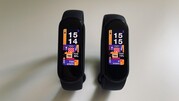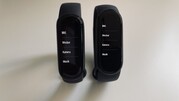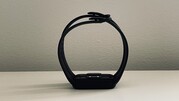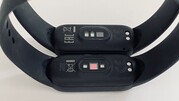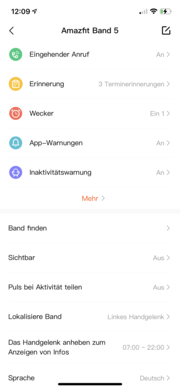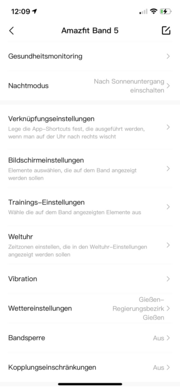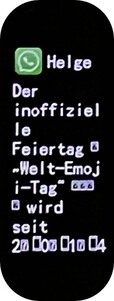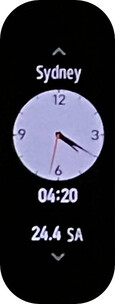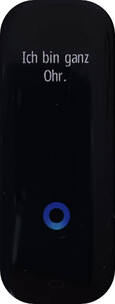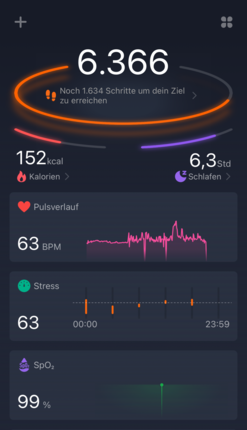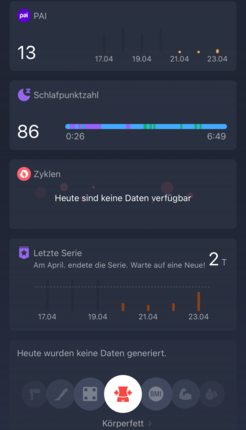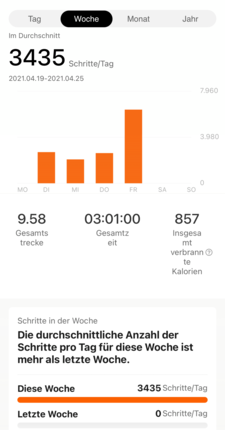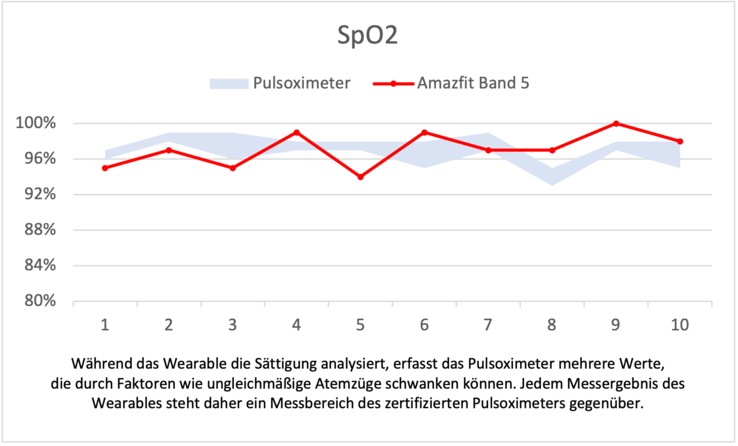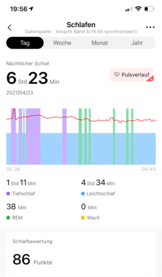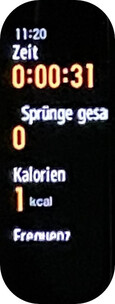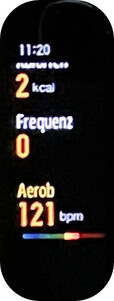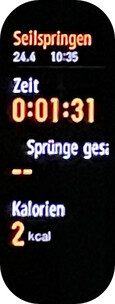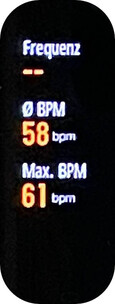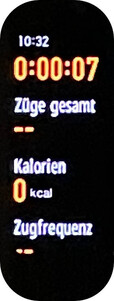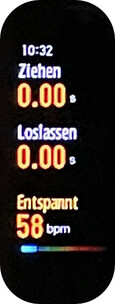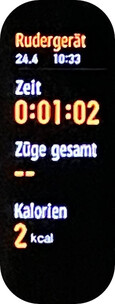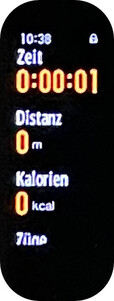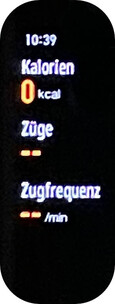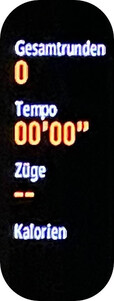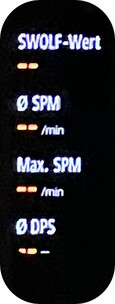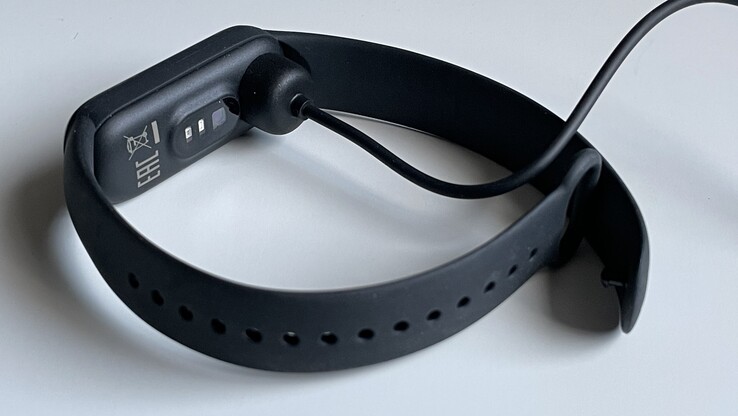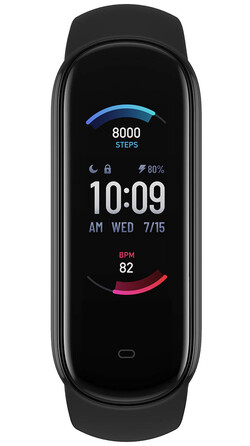Between Xiaomi Mi Smart Band 5 and Band 6: Huami's Amazfit Band 5 fitness tracker in test
Case and features - fitness tracker without GPS
The Amazfit Band 5 followed the Mi Smart Band 5 from Xiaomi, but only came to Germany a few months later. The hardware of the two bands is largely identical, with two differences: Huami, the manufacturer behind the Amazfit brand, additionally measures blood oxygen saturation (SpO2) with its Band 5 and integrates Amazon's Alexa voice assistant.
None of the trackers have GPS; the sensors only record health and movement data in each case. All three are waterproof up to 5 ATM and can be removed from the original band: For the Tracker from Xiaomi there are numerous third-party bands that fit both.
The AMOLED of the two has a diagonal of 1.1 inches. Resolution and pixel density are identical, but Huami increases the font size in the menus compared to Xiaomi. For the Mi SmartBand 6, Xiaomi goes for a 1.56-inch display that makes better use of the surface rather than just a section of it.
With a beefy wrist, you may prefer Amazfit's Band 5 because it's 16 mm longer than Xiaomi's. As things stand, Xiaomi has not changed the band length for the Smart Band 6.
Huami Amazfit Band 5 and Xiaomi Mi Smart Band 5 in comparison: Both only use a section of the surface for the display. Huami makes the band a bit longer than Xiaomi and increases the font size in the menus. In the last picture with the back and sensors of the two wearables, the one at the back is Huami's band.
Setup and operation - Alexa voice assistant on board
The Band 5 connects to the iPhone or an Android smartphone via the Zepp app. Before that, you have to log in to the manufacturer's server.
Possible settings include plans for the always-on display and display activation via gesture, vibration patterns for different alarms and notifications, and health monitoring options, which we will discuss in more detail below.
The applications and widgets are set up via the app and then appear on the band via horizontal gestures or vertical swipes. The tracker's functions include a timer, a stopwatch, alarms and scheduled reminders, as well as a weather widget with a forecast for the next 6 days.
In testing with an iPhone 12 Pro, controls for the player and smartphone camera also worked via the smart wearable. When you take the band off, an optional password protects it from unauthorized use.
Telephony and notifications
There is no message overview. When you open the notifications, you can only scroll through them one after the other and recognize the origin of the message by the icon
Placeholders appear instead of emojis. If Huami omitted them instead, the message would be easier to read and also shorter, which would not be a mistake on the small display. If you do not delete the message it automatically disappears as soon as you have read it on the smartphone.
Voice assistant
As small as the tracker is - a voice assistant is not missing. To use it, you have to connect your account with your Amazon account via the app. After that, Alexa is ready to talk with its own widget and listens to the commands that are entered via the small microphone at the bottom edge of the casing.
This worked well in the test and also in German. Alexa often reported that the network was overloaded, but it had already executed the command at that point.
Health and fitness - doubts about sleep tracking
Via the Zepp app, you can connect your account with Google Fit or Apple Health, as well as with Strava or Relive. Huami has developed its own optical PPG bio-tracking sensor for tracking and credits it with high accuracy. The Band 5 counts steps just as reliably as Xiaomi's Mi Smart Band 5 in our test.
The app synchronizes the collected data via the manufacturer's server and presents the analyses in a daily dashboard. On the detail pages, you can go back further and look at longer periods of time, such as here for the number of steps.
Heart rate, heart rhythm and blood oxygen saturation
The Band 5 measures the heart rate on demand every minute around the clock and issues a warning when the pulse exceeds a previously defined frequency. Alternative intervals for the measurement are 5, 10 and 30 minutes. It is not possible to set a lower pulse limit. Xiaomi also does not provide a warning for a too low pulse. Both infer stress effects from the heart rate variability. The oxygen saturation is measured manually.
We compare the measurement results with a certified pulse oximeter. While the Band 5 measures the heart rate reliably for the most part, the result of the saturation analysis is rarely within the measurement range of the pulse oximeter. However, the deviations are small.
Sleep recording
The Huami tracker also records the heart rate at night and overlays it with the recorded sleep phases in the sleep log's diagram. However, the test revealed inconsistencies that cast doubt on the reliability: The log included here, for example, does not reflect a short wakefulness phase that occurred during the night in question.
Training
When training, the user can choose between 11 sports: Outdoor walking, running and cycling, pool swimming, cross trainer, rowing machine, treadmill, spinning, yoga, rope skipping and free workout. The range coincides with that of the Mi Smart Band 5 from Xiaomi. However, we can expect more with the Band 6: According to the information so far, Xiaomi increases the number of sports modes to 30.
When walking, running and cycling, the fitness tracker only records a route with the help of the smartphone GPS. For some sports, the trackers make use of their motion sensors and count, for example, the jumps when jumping rope and the pulls when rowing or swimming. The pool swimming mode automatically locks the display, which can only be unlocked later with a precise gesture.
The following screens show the training screen and the log with zero values for rope jumping, rowing and swimming, respectively.
Battery life
Huami states an average runtime of 15 days, which is one day more than Xiaomi. In the test, we managed just under 10 days after activating the automatic motion detection, the stress and sleep analysis, and an interval of 5 minutes for measuring the heart rate.
The Amazfit Band 5 needs a bit less than 1.5 hours for a full battery charge.
Verdict
At this point, the Amazfit Band 5 is a good choice: It barely costs more than the Mi Smart Band 5 from Xiaomi, but it comes with a voice assistant and measures the oxygen saturation.
You can also get that with the Mi Smart Band 6. The larger display is particularly appealing. However, it is also almost twice as expensive, at least for now. As soon as the price drops, it should outshine the other two.
The Amazfit Band 5 is currently a good choice. That will change when the price of Xiaomi's Mi Band 6 drops.
A larger display can also be found in the Huawei Band 6 and the fitness tracker of the same name from Honor. The hardware is similar to that of Amazfit. Both lack GPS, and both measure oxygen saturation; even automatically at night, and the Huawei Band also during the day. The latter's training app also tops the Band 6 from Xiaomi. The RRP is somewhat higher at 59 Euros (~$71, Amazon), but the display is much better, for example, for displaying messenger messages. The Honor Band 6 costs regularly 49 Euros (~$59) and is at Amazon in connection with a discount campaign.
Price and availability
The fitness tracker from Huami is available in olive, orange and black. The Amazfit Band 5 is priced at $39.99 (Amazon) only just below the Mi Smart Band 5 at about $44.99 (Amazon). Dealers currently list the new band 6 of Xiaomi with 49.99 Euros (~$60, Notebooksbilliger).




